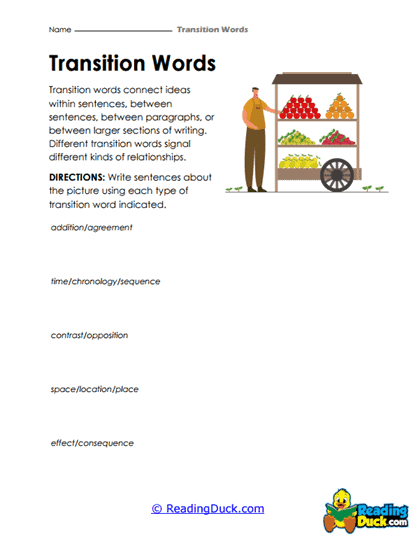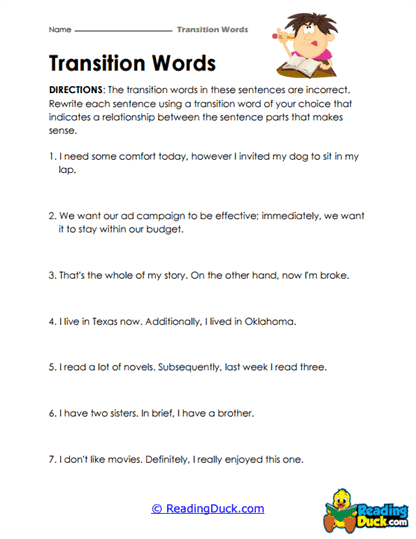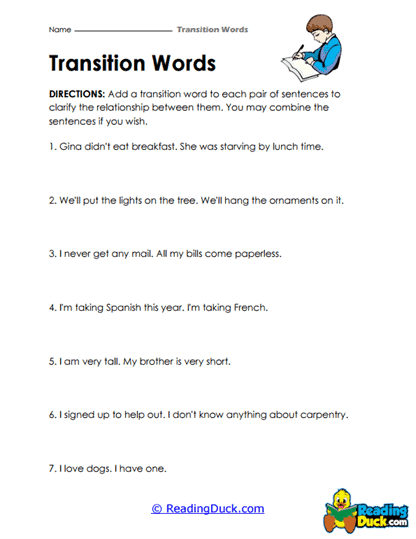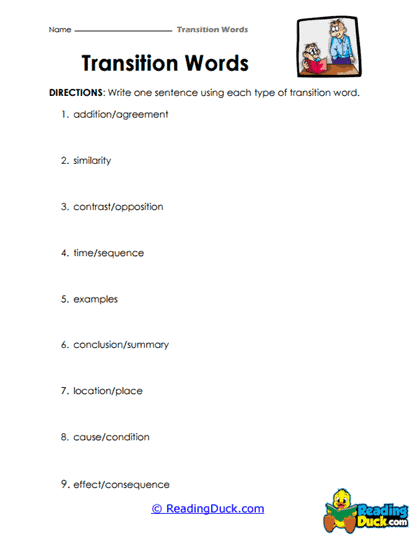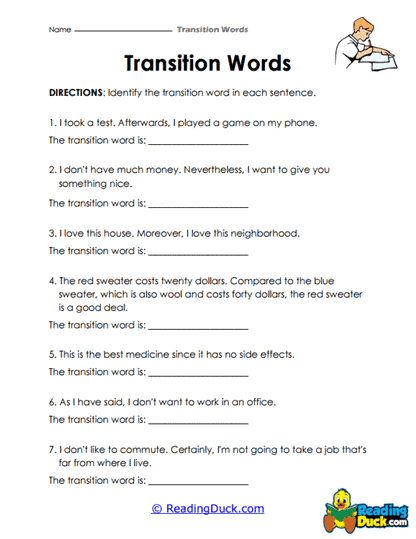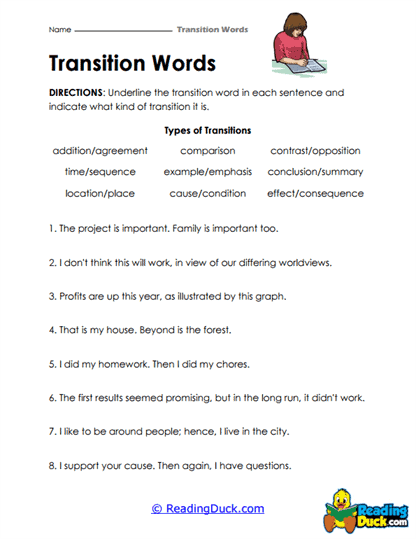Transition Words Worksheets
About Our Transition Words Worksheets
Our Transition Words Worksheets collection is a valuable for students looking to enhance their writing and communication skills by mastering the use of transition words. Transition words-such as "therefore," "however," "in addition," and "as a result"-are essential in helping students structure their writing more logically and smoothly. By using these words effectively, students can connect ideas and thoughts coherently, improving the flow of their essays, reports, and even verbal communication.
These worksheets emphasize the importance of logical flow and coherence in writing, encouraging students to use connectors like "however," "as a result," and "in addition" to link ideas effectively. Each worksheet comes in a downloadable PDF format and includes an answer key, making them convenient and user-friendly for teachers, parents, and students alike.
Through a variety of engaging activities; such as identifying, classifying, and rewriting sentences; students actively apply transition words to express relationships like contrast, addition, and cause and effect. This interactive approach supports comprehension and retention, turning passive recognition into active writing skills. The materials are highly adaptable, fitting seamlessly into classroom instruction, homework routines, or independent study.
The collection is thoughtfully designed to support a range of grade levels and writing abilities. Younger learners start with basic transitions, while more advanced students tackle complex phrases to refine their essay writing and critical thinking. The worksheets not only align with academic standards but also prepare students for real-world communication by reinforcing clarity and logical structure in writing.
Whether used in solo practice or group lessons, these worksheets cater to various learning styles and teaching strategies. They serve as an excellent resource for reinforcing grammar and composition skills, as well as for building confidence in writing across subjects. With each exercise, students develop a deeper understanding of how transitions shape meaning and guide readers through their ideas.
This worksheet collection supports long-term writing growth. By internalizing the role of transitions, students gain the tools they need to communicate more clearly, persuasively, and effectively. The worksheets provide both structure and flexibility, making them a valuable addition to any language arts curriculum.
Available in PDF format, these worksheets are easy to view, download, and print, making them accessible for teachers, students, and parents. Each worksheet includes a downloadable answer key for quick and accurate feedback, ensuring students can track their progress. These resources are designed for versatile use, whether in the classroom, as part of homework, or for independent study. By focusing on transition words, our worksheets help students build critical vocabulary skills that support both academic success and everyday communication.
What Are Transition Words?
Also known as linking words or discourse markers, transition words, are words or phrases that connect ideas, sentences, or paragraphs to help writing flow logically and coherently. They serve as signposts for readers, showing relationships between thoughts and guiding them through the structure of a text. Transition words clarify meaning by highlighting how ideas are related; whether through contrast, cause and effect, addition, time, or sequence.
Transition words are essential elements in writing that help improve clarity, coherence, and flow by linking ideas logically across sentences and paragraphs. They act as bridges between thoughts, making it easier for readers to follow the writer's message without confusion or abrupt shifts. By signaling relationships such as contrast with "however," cause and effect with "therefore," or addition with "in addition". These words show how ideas are connected and support a smooth, natural progression of thought. Without transition words, writing can feel disjointed or hard to follow, but with them, it becomes more structured, persuasive, and reader-friendly.
Types of Transition Words and 3 Examples
Here are three examples of transition words, each serving a different function:
1. "However" - Contrast
I enjoy hiking. However, I don't like camping overnight.
This signals a contrast between two related but opposing ideas.
2. "Therefore" - Cause and effect
She studied every day for a month. Therefore, she passed the exam with ease.
This shows that one idea is a direct result of the other.
3. "In addition" - Addition
The museum has an impressive art collection. In addition, it offers free workshops on weekends.
This adds more information to support the previous statement.

